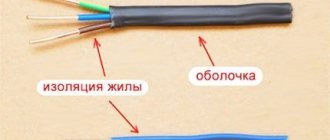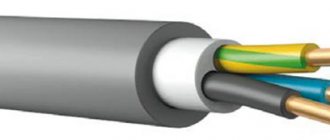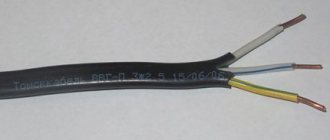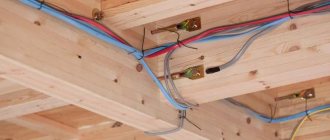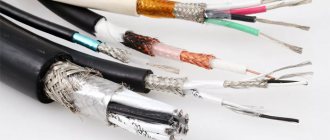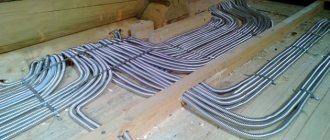Any professional installer can handle the installation of electrical wiring indoors, but laying cables over the air almost always causes certain problems and difficulties.
There are two main methods that allow communications between buildings - by air and underground. In each case there are certain advantages and disadvantages.
Installation of SIP wires over the air
Advantages of the method:
- less labor-intensive work;
- in comparison with underground communications, it is almost always possible to lay a cable over the air;
- shorter cable length.
Aerial cable laying is simpler and cheaper than underground
. Disadvantages:
- poor resistance to static electricity and lightning discharge;
- the need for high strength and resistance to severe weather conditions;
- the likelihood of timely failure, which may be due to friction against other objects or cracking due to moisture accumulation.
However, there are special recommendations for the selection of materials, installation and operation technologies that make it possible to eliminate all of the listed disadvantages.
Application area
Cable laying over the air is possible in electrical networks whose voltage does not exceed 1000 V, which complies with the rules of the PUE. Most of these procedures are performed to connect two buildings or a building to a power line, and the distance between objects should be small. This option is suitable in all cases where it is not possible to place power line supports or dig trenches, or customers want to save money, since installing underground wiring will never be feasible from a financial point of view.
Air laying is usually used when the distance between buildings is short
These technologies can be used to equip lighting systems indoors with high ceilings, which include production workshops and huge warehouses. Special cable braces allow you to organize high-quality street lighting.
Owners of country or private houses can avoid the labor-intensive work of digging trenches, since it is much more economical and easier to stretch the cable over the air from the main distribution board to many outbuildings, including a workshop, garage, summer kitchen or bathhouse.
Air supply of electricity to a private house
Thanks to the presence of the cable, it is possible to lay both three-core electrical wiring of low power and a cable with a large cross-section designed to power powerful equipment.
Scheme
First you need to think about the route along which the wiring will go through the building or apartment. Try not to cause major damage to the room. Cables can be laid in special pipes or along building structures (in the voids of the ceiling or floor). The gaps between the tubes will need to be sealed with non-combustible materials (cement, clay).
Make a drawing of the house, indicate all the places where you are going to install sockets, switches and lighting points
Also pay attention to points where there will be a large amount of equipment. Electrical wiring involves determining the required number of energy-consuming devices and how to connect them
The wiring diagram determines the distance, number of wires and accessories.
In general, the wiring and installation diagram in the building can be drawn up arbitrarily, but with recommendations. Try to ground the sockets for powerful household appliances (stove, boiler, washing machine), that is, make the wiring three-phase. Light fixtures can only be grounded in the bathroom.
Having marked the connection nodes, mark the wires leading to them. There are several simple rules, in accordance with the requirements of SNIP and PUE for electrical installation work, which should be followed when marking the circuit:
- installation of electrical wiring on trays, boxes, sockets should be carried out in easily accessible places so that replacement later does not cause trouble;
- switches are placed 1.5 meters above the floor or 70 cm. The distance to gas stoves and batteries is at least 50 cm. One socket is needed per 6 square meters of room. In the kitchen, their number is calculated based on how many household appliances there will be. It is advisable to install an isolation transformer in the bathroom for an outlet in this room. It is prohibited to install sockets in the toilet;
- During electrical installation work, wires are placed on the walls vertically or horizontally, on the ceiling - at the shortest distance to the lighting point;
- groups and individual sockets, lighting points are connected to the distribution board, where auto switches will be installed. The power of the machine is calculated based on the maximum power of consumers: for individual sockets or groups - 16, 25, 40 A, and for lighting groups 10-16 A.
Preparatory work
Any installation work begins with a preparatory stage, including calculations. First you need to calculate the required wire cross-section. This characteristic directly depends on the total power of the switched electrical devices. After this, you need to measure the distance from one connected object to the distribution panel. It is important to take into account the rises and turns of the cable line.
As soon as the previous calculations are completed, you can proceed to the selection of the cable. This element of the system must withstand the load of the installed cable on each section of the route. To avoid line breakage during external installation, to calculate the strength of the cable and other fasteners, take the weight of the cable multiplied by three. It is almost always enough to take a galvanized cable with a diameter of 4.5 or 6.7 mm. For the string method, steel or hot-rolled varnished wire with a thickness of at least 5 mm is suitable.
Laying the cable along the support cable
see also
Comments 45
I buried 16m in metal plastic. for 2 bayonets, next to the path, so that no one would dig. 5 years so far no problems.
I have 3 meters from the bathhouse to the toilet. The electrical panel in the bathhouse. Consider running a cable along the bathhouse and hanging it from the bathhouse to the toilet on a metal cable. VVG wire 3 by 2.5 in a polypropylene corrugation. It’s been hanging like this for 3 years, everything is fine. Withstood the snow winter and rainy summer.
Along the fence, in the corrugation. And don’t say that there is no fence made of prof. Liszt.
The cross-section is at least 2.5 mm. The cable (wire) is better, of course, non-flammable. Provide a distribution box for the input machine and 2 outgoing lines (heating element and sockets). If external installation is possible, then use polypropylene as an option. I liked working with them. There are plenty of fittings, the prices are cheap. The track is sealed and there is always the possibility of crashing into it. Transitions, if required, are carried out on a cable in a metal corrugation. I refused to lay it in the ground. Digging deep (in terms of freezing level) is simply too lazy. And the water may be too close, and since it’s summer with constant rains, the cable will lie in the swamp.
In HDPE corrugated with a double wall at a depth of 50cm. Cable 3x2.5 num or vvgng. If there is no land, then to connect the boiler and pan you will have to weld a triangle or buy a ready-made solution. I do this for myself. Double-wall corrugated HDPE, 3x4 VVGNG cable (available), entry through the floor through a rigid pipe, switchboard with automatic switches, 3x2.5 sockets, 3x2.5 boiler and 1.5 light. THOSE. 4 modules input 25A, sockets, boiler 16A light 10A. Boxing, sockets, switches, IP 65 lamps in the workshop and shower, a simple lamp in the toilet. The walls are laid in HDPE rigid pipes.
One machine gun is enough for him) he’ll take him to the toilet, put the box there and throw it in front of the light, sockets, and switch) why bother so much...
I’m so bothered by the fact that my utility room is combined with a toilet and shower. In the utility room you drill, then saw, or do whatever else)
One machine gun is enough for him) he’ll take him to the toilet, put the box there and throw it in front of the light, sockets, and switch) why bother so much...
It is better to turn off the shower heater when bathing. And this means a separate machine.
He wrote in the topic through the outlet...
This is through the outlet for now. The tank itself is heated. The season was poking, and then I got tired of it. Moreover, the contacts begin to heat up, after all, it is better to make 2.5 kW in a reliable way, and not through a lousy plug-socket. I doubt that he will install expensive and high-quality ones, much less hermetic ones. I would like to connect my tank over time via a time relay. That I didn’t think about it at all and didn’t forget to turn it on.
This is all nonsense) you dig a trench about knee deep, there is a cable there and that’s it) A 3x2.5 cable is better, in a HDPE pipe.
What does better mean? Either in a pipe or armored.
People here write to pull the sip) for light and a couple of sockets and a heating element for the toilet) a 3x2.5 cable can withstand up to 5 kW) a simple black plastic HDPE pipe and that’s all)
You don’t understand, if there is no pipe then the cable must be armored. And it doesn’t matter, at least let the PVS pull
Selecting the diameter and material of the cable
Galvanized steel wire is suitable for supports located at a distance of no more than 6 m. Provided that the weight of the wiring is small, its diameter can be 2-3 mm. If the distance between supports is higher, especially more than 10 m, and a heavy cable is used, it is imperative to choose a galvanized cable with a diameter of about 6 mm. It is able to withstand cable loads with a cross-section of up to 10 square meters. mm. Large-sized products are rarely used in private homes, which is due to the lack of need for high power. The above cable can be used to install a heavy cable followed by fastening 5-6 street lights equipped with a lightweight housing.
To calculate the weight of the cable, wind it and use a regular scale. This value can be calculated based on the product brand indicated in the technical data sheet. There you will find the cable weight per 1 m length. It remains to multiply this value by the length of the cable route, as a result it will become known what load it will exert on the steel wire or cable.
Weight and other technical characteristics of the SIP-2 cable
In domestic conditions, a hidden wiring cable can be used. To protect the insulation, it is enough to hide it in a light weight corrugated pipe. The Internet and various reference books are full of tables that allow you to determine the weight of a cable based on its brand. There are also special calculators.
For high current loads, it is recommended to use products designed for air installation:
- AVT and ART brand cable with built-in support cable;
- АВРГ, АПВГ and АВВГ, attached to a steel cable.
Advantages of open wiring
Corrugated
Wiring done openly, that is, located in boxes, corrugation or something else, has a number of advantages:
the wiring is protected from deformation and accidental damage; no one will connect something of their own (unless, of course, they guess to open the box lid or cut the corrugation); a metal hose used in fire hazardous areas not only protects against fire, but also secures the cable so that it does not come out of it; if necessary, you can leave a supply of wire in the cable channels; the aesthetics of the installation are preserved, which is important, because no one wants their utility room to look like a barn.
For more detailed information on box installation, you can watch the following video below:
Fastening the cable to the cable: support and tension elements of the air wiring
There are several fasteners used for mounting on the walls of buildings and other objects to secure guy wires. The design of the future fastening depends on the material and overall dimensions of the cable.
Let's list a few varieties:
- Tension bolt, hook and anchor. This configuration is suitable for a flexible multi-core cable, which can be laid using rolled steel wire with a diameter of 6 mm.
- Several anchors for tensioning strings of small diameter are suitable for a light cable, the cross-section of which does not exceed 6 mm, and the distance between the switched objects is 10 m. In this case, the installation of lighting devices is unacceptable.
- Special cable and wire rod anchors can support heavy electrical wiring connecting objects at any distance with support spacing up to 12 m.
Installing a tension coupling for the support cable
There are also fasteners that allow you to connect two parallel lines. One is used to organize power supply, the other is used to install lighting fixtures. In the first case, a power cable with a cross-section of 10-35 square meters is installed. mm, in the second - lighting devices and distribution boxes containing copper wires 2.5-4 mm.
In the figure below you can see the variety of fasteners used for installing overhead wiring:
Methods for attaching aerial cable
Wires for wiring.
For external wiring, as well as for internal wiring, you can use VVG, NYM, ShPVVP, PVS wires; in addition, for external wiring, wires with textile braiding are used - retro cables. If the wire will be located outdoors, the wire must be stranded and its cross-section must be greater than 2.5 mm². Cables VVG and NYM are hard, and SHPVVP and PVS are soft, this is taken into account when wiring.
Different wires are braided in different colors, which makes them easier to choose when purchasing. Wires with copper conductors are better than aluminum ones. They conduct electric current better, last longer, in addition, they are less chemically active, but they have the disadvantage of oxidizing very quickly in air.
Requirements for installation of end fastenings and installation features
It is highly not recommended to fix end/fasteners to the roof or decorative cladding of a building. If a cable is used that must withstand significant loads, then for fastening you should use steel plates installed on load-bearing walls and then tightened using through bolts.
Above pedestrian areas, cable lines should be laid at a height of no lower than 2.7 m, on roadways - 6 m. String anchors for light loads can be tightened with simple concrete screws.
The best option is to install tension anchors in the walls of the building during its construction, but in practice this approach is used extremely rarely. Therefore, in the future you have to create holes in the walls using a hammer drill. A metal plate equipped with a bolted contact for grounding is mounted below the end fastening. It usually drops by 20-30 cm. The plate is connected to a rolled wire for grounding by welding. Grounding can be done using a copper conductor with a cross section of 2.5 square meters. mm.
Fastening to a concrete wall with anchor bolts
Installation technology
After carrying out calculations and purchasing materials with the necessary technical parameters, they begin to install anchors and other fastening elements of electrical wiring. In most cases, they make do with steel plates, which are tightened with special pins. The rings necessary for fastening the cable are welded to them. Tension avoids sagging by evenly distributing the load along the wall.
One end of the cable is secured using loop clamps. Then screw couplings are attached to the second end in order, for example, to tension the cable between posts and bring it to the state of a string. A special bandage is used to tie the cable to the strings. For installation of cable wiring outdoors, ordinary plastic clamps, strips of galvanized iron or wire are suitable. The distance between the wire fastenings to the cable should not exceed 0.6-0.8 m.
Recommendation from practice
If you use a tying wire to secure the cable to the cable, be careful not to over-tighten it so as not to accidentally cut the insulation or strands. To eliminate such situations, you can place a strong gasket made of insulating material between the bandage and the cable.
At all attachment points, you must adhere to the same winding pattern - at least 7 turns of the bandage. If plastic clamps are used, make sure that their operating parameters comply: they must withstand low and high temperatures, otherwise they may dry out and fall apart.
For additional line protection and cable insulation, it is recommended to use corrugated pipes. This will reduce the negative impact of bad weather conditions, reduce the financial costs of operation and subsequent possible restoration of the route.
Carrying wires through the air in a corrugated pipe
If it is not possible to collect the line from above, you can try to do it on the ground. You should attach the cable to the cable right there, and then pull it between the supports.
Homemade sliding suspension
Construction stores sell a variety of hangers for cable wiring. However, with a small amount of work, you can do it on your own by creating a homemade fastener.
For this you will need:
- wire cutters;
- round nose pliers;
- galvanized steel wire (preferably more flexible);
- a rod whose diameter is higher than the given value of the cable being installed.
Using wire cutters, create several pieces of wire 25-30 cm long. Take the pliers and make an air loop in the middle of each of them. Its diameter should be equal to the size of the cable being laid, since the next step is to thread it through the “rings”.
Wrap the wire around the rod to create the components to secure the cable to the cable. First, wind one end, then the other end. The pitch of the resulting spiral should be about 20 mm. With these steps you will create a homemade cable hanger.
To lay the cable through the air, secure the cable, then place the hangers at intervals of 50-80 cm and thread the cable through them. After this, the free end of the cable is fixed to the second building.
Preliminary measures before installation
At the first stage, it is necessary to determine how much power will be consumed by electrical appliances in the structures that are planned to be provided with electricity. Based on the power consumption, the cross-section of the cable wires is calculated, its length and weight are taken into account. These parameters determine which fasteners to use, the diameter and material of the cable. To calculate power consumption and cable cross-section, a more detailed study of a separate topic is required. In simplified form it looks like this:
The power of all electrical appliances that are supposed to be used in the calculated network is summed up. The power of each device is indicated in product passports or nameplates on the housing. The simplest example of a lighting lamp is always written 40 on them; 60; 75 or 100 or more watts.
∑Р = P1 + P2 +…Pn = 3.7 kW. (3700 W) – Total power.
Determine the maximum possible current in the circuit
I = ∑Р/ U=3700 W/220 V = 16.8 A. – Maximum current.
U – network voltage.
To determine the cross-section of wires in a cable, use the table
In our case, we choose a maximum current value slightly greater than 19A, taking into account that additional household appliances may be used in the future. According to the table, we obtain a power of 4.1 kW, which corresponds to a copper wire cross-section of 1.5 mm. You need to understand that the cross section is not the diameter, it is calculated using the formula:
Formula for calculating wire cross-section
Experienced electricians are well aware of the standards of cables and wires and determine the cross-section by eye. For ordinary consumers, there are tables for determining the cross-section by diameter; it is enough to measure the diameter of the wire with a micrometer or caliper and determine its cross-section using the table.
Determining wire cross-section by diameter
The next stage of preliminary work is measuring the length of the cable from the distribution board in the house to the switchgear (switchgear) on the building to which the cable structure is stretched. This can be done with a regular tape measure,
Is it possible to replace a cable with a rope?
In short, it’s impossible. The rope does not have the necessary properties and qualities, since when exposed to negative environmental factors, fabric products quickly fail. The rope is stretchable, easily frays and breaks. Due to low strength, sagging occurs, and a wire break will create an electrical and fire hazard.
Cable wiring installation technology
Theoretically, installing cables over the air is easier than organizing underground communications. However, in practice it involves meeting important requirements and performing work that only qualified and experienced electricians can do. The slightest mistakes can lead to a decrease in the safety of the cable line, so it is recommended to contact professional technicians for at least a consultation.
Conclusions: should you choose an overhead or cable line?
An air line is suitable for you if:
An underground cable line is suitable for you if:
- The appearance of your site is important to you.
- In your area, there are strong winds and wires often break due to falling trees.
- You have large-sized agricultural equipment, and you need to power several buildings in your yard.
- The power line support is located more than 25 m from your home, and you do not want to spend money on installing an additional support.

